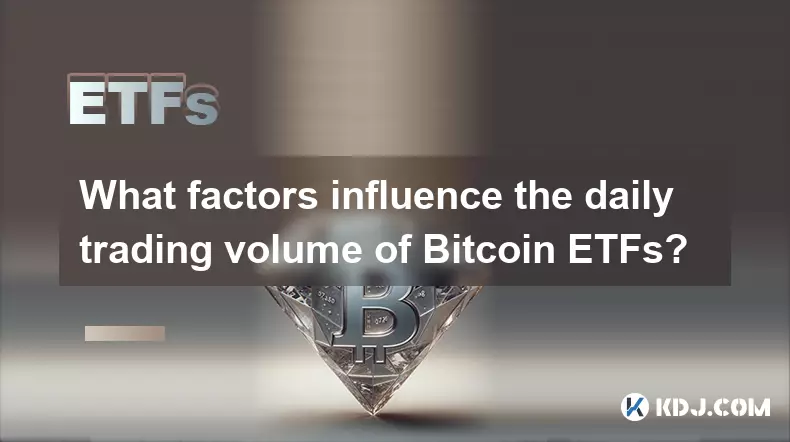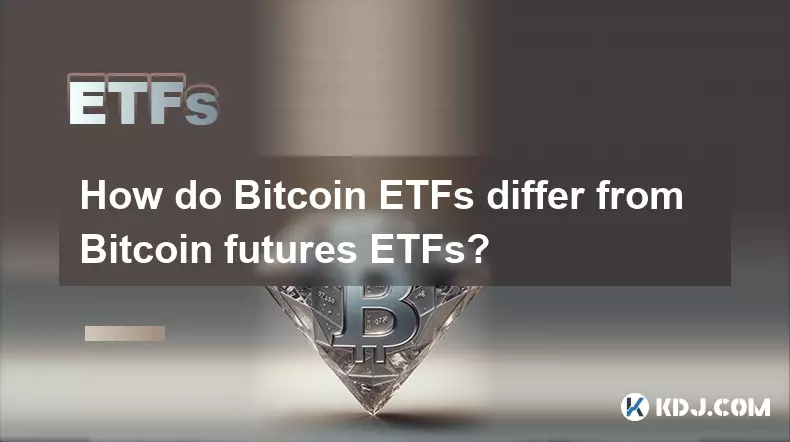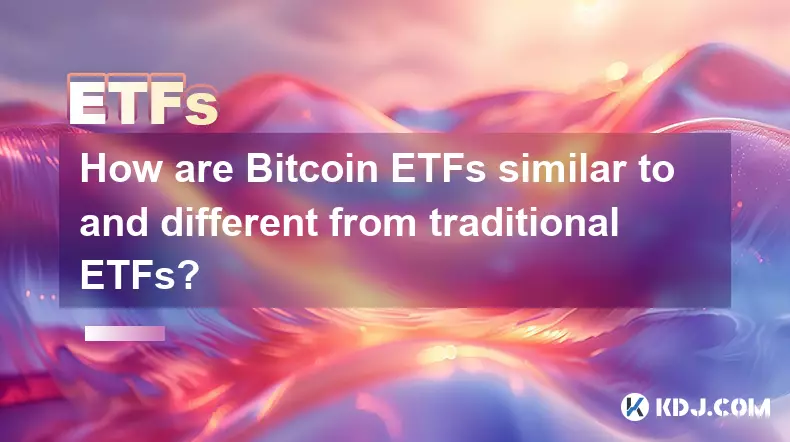-
 bitcoin
bitcoin $109667.069529 USD
-3.03% -
 ethereum
ethereum $3936.685804 USD
-4.07% -
 tether
tether $1.000493 USD
0.01% -
 xrp
xrp $2.771823 USD
-4.74% -
 bnb
bnb $957.805027 USD
-5.34% -
 solana
solana $196.735100 USD
-6.68% -
 usd-coin
usd-coin $0.999727 USD
-0.01% -
 dogecoin
dogecoin $0.227355 USD
-5.12% -
 tron
tron $0.335205 USD
-0.81% -
 cardano
cardano $0.779256 USD
-3.59% -
 ethena-usde
ethena-usde $0.999900 USD
-0.06% -
 hyperliquid
hyperliquid $42.492095 USD
-6.61% -
 chainlink
chainlink $20.501853 USD
-4.34% -
 avalanche
avalanche $28.952606 USD
-11.21% -
 stellar
stellar $0.356038 USD
-3.93%
How does a Bitcoin ETF trade?
A Bitcoin ETF lets investors gain exposure to Bitcoin’s price through traditional markets, offering liquidity, regulatory oversight, and ease of access without handling crypto directly.
Sep 26, 2025 at 08:36 am

Understanding the Mechanics of a Bitcoin ETF
1. A Bitcoin ETF, or exchange-traded fund, trades on traditional stock exchanges just like any other publicly listed security. Investors do not buy or hold actual Bitcoin; instead, they purchase shares in a fund that tracks the price of Bitcoin. These shares reflect the underlying value of Bitcoin, often backed by direct holdings or futures contracts.
2. The structure of a Bitcoin ETF involves an authorized participant who creates and redeems shares in large blocks known as creation units. These participants work with the fund issuer to maintain supply in line with demand. When investor interest rises, new shares are issued. When demand falls, shares are redeemed and taken off the market.
3. Pricing for a Bitcoin ETF is determined by market forces during regular trading hours. While the ETF aims to mirror Bitcoin’s spot price, discrepancies can occur due to premiums or discounts based on investor sentiment, liquidity, and regulatory constraints. Arbitrageurs help narrow these gaps by exploiting price differences between the ETF and the underlying asset.
4. Unlike buying Bitcoin directly on a cryptocurrency exchange, trading a Bitcoin ETF occurs through standard brokerage accounts. This accessibility allows traditional investors to gain exposure to Bitcoin without managing private keys, wallets, or navigating crypto-specific platforms.
5. Regulatory oversight plays a significant role in how a Bitcoin ETF operates. Approval from financial authorities such as the U.S. Securities and Exchange Commission ensures compliance with disclosure, custody, and reporting standards. This layer of supervision increases investor confidence but also imposes operational limitations on the fund’s structure.
Liquidity and Market Access
1. One of the primary advantages of a Bitcoin ETF is enhanced liquidity. Since it trades on established equity markets, institutional and retail investors can enter and exit positions quickly using familiar tools and order types, including limit and stop-loss orders.
2. The presence of market makers ensures continuous bid-ask spreads, improving execution quality. These entities provide stability, especially during periods of high volatility in the broader crypto market.
3. Global investors who face restrictions on accessing cryptocurrency exchanges can use Bitcoin ETFs as a compliant gateway to digital asset exposure. This expands the potential investor base beyond regions with mature crypto infrastructures.
4. Trading volume in a Bitcoin ETF often correlates with macroeconomic indicators and news cycles affecting both traditional finance and the crypto sector. High-volume days typically follow major economic data releases or regulatory announcements.
5. The integration of Bitcoin ETFs into retirement accounts and managed portfolios has significantly increased capital inflows, reinforcing their role as mainstream investment vehicles.
Pricing and Tracking Accuracy
1. A key metric for evaluating a Bitcoin ETF is its tracking error—the degree to which the fund’s performance deviates from the actual price of Bitcoin. Funds backed by physical Bitcoin tend to have lower tracking errors compared to those relying on futures contracts.
2. Futures-based Bitcoin ETFs may experience contango or backwardation in the derivatives market, impacting returns. In contango, future prices are higher than spot prices, leading to roll costs that erode long-term performance.
3. Expense ratios vary across different Bitcoin ETFs and influence net returns. Lower fees generally attract more assets under management, intensifying competition among issuers.
4. Premiums and discounts to net asset value (NAV) are monitored closely. Persistent deviations can signal market inefficiencies or structural issues in the fund’s arbitrage mechanism.
5. Transparency in daily holdings reports enables investors to verify whether the ETF maintains adequate backing, reducing counterparty risk and enhancing trust.
Custody and Security Considerations
1. Custody of the underlying Bitcoin is a critical component of a physically backed ETF. Reputable custodians employ cold storage solutions, multi-signature wallets, and insurance policies to protect assets against theft and loss.
2. Regulatory requirements mandate regular audits and proof-of-reserves disclosures. These practices ensure that the ETF holds the claimed amount of Bitcoin and prevent fractional reserve practices.
3. Jurisdictional risks affect custody arrangements. Funds domiciled in countries with strong investor protection laws offer greater legal recourse in case of disputes or insolvency.
4. The involvement of regulated financial institutions as custodians bridges the gap between decentralized cryptocurrencies and centralized financial systems, fostering wider adoption.
5. Cybersecurity protocols are continuously updated to address evolving threats. Third-party penetration testing and compliance with industry standards like SOC 2 add layers of assurance for stakeholders.
Frequently Asked Questions
How is a Bitcoin ETF different from buying Bitcoin directly?A Bitcoin ETF allows investors to gain exposure to Bitcoin’s price movements without holding the asset itself. Direct ownership requires managing wallets and private keys, while an ETF is held in a brokerage account and subject to securities regulations.
Can a Bitcoin ETF run out of Bitcoin?No. The fund issuer ensures that each share is backed by a proportional amount of Bitcoin held in custody. Authorized participants adjust the supply of shares based on demand, maintaining alignment with reserves.
Do Bitcoin ETFs pay dividends?Bitcoin ETFs do not distribute dividends because Bitcoin does not generate income. Returns are derived solely from changes in the asset’s market price.
Are all Bitcoin ETFs backed by real Bitcoin?Not all. Some ETFs use Bitcoin futures contracts instead of holding actual coins. Physically backed ETFs are generally preferred for their direct correlation to spot prices and reduced roll yield risks.
Disclaimer:info@kdj.com
The information provided is not trading advice. kdj.com does not assume any responsibility for any investments made based on the information provided in this article. Cryptocurrencies are highly volatile and it is highly recommended that you invest with caution after thorough research!
If you believe that the content used on this website infringes your copyright, please contact us immediately (info@kdj.com) and we will delete it promptly.
- XRP Price: October Rally on the Horizon After September Consolidation?
- 2025-09-26 16:25:13
- Bitcoin Price Wobbles: Investors Buy the Dip as Powell's Words Stir Uncertainty
- 2025-09-26 16:25:13
- Kaspa Price, Smart Contracts, and the 2026 Forecast: A New York Minute
- 2025-09-26 16:30:01
- Bitwise, Hyperliquid ETF, and HYPE Token: What's the Deal?
- 2025-09-26 16:45:14
- B HODL, Bitcoin, and Treasury Purchases: The New Institutional Playbook
- 2025-09-26 17:05:15
- Cloudflare, Stablecoins, and AI Agents: A New Era of Automated Finance
- 2025-09-26 16:45:14
Related knowledge

Will Bitcoin ETFs affect Bitcoin's decentralized nature?
Sep 24,2025 at 02:00am
Impact of Bitcoin ETFs on Market Accessibility1. Bitcoin ETFs have significantly lowered the barrier to entry for traditional investors who may not be...

Which exchanges list Bitcoin ETFs?
Sep 26,2025 at 03:18am
Major Cryptocurrency Exchanges Offering Bitcoin ETFs1. The landscape of digital asset trading has evolved significantly with the introduction of Bitco...

Is the volatility of Bitcoin ETFs consistent with Bitcoin?
Sep 26,2025 at 01:18am
Bitcoin ETFs and Their Relationship to Bitcoin Price Movements1. Bitcoin ETFs are financial instruments designed to mirror the price of Bitcoin withou...

What factors influence the daily trading volume of Bitcoin ETFs?
Sep 23,2025 at 07:18am
Market Sentiment and Investor Confidence1. The perception of economic stability heavily affects how investors approach Bitcoin ETFs. When macroeconomi...

How do Bitcoin ETFs differ from Bitcoin futures ETFs?
Sep 23,2025 at 09:37pm
Differences Between Bitcoin ETFs and Bitcoin Futures ETFs 1. A Bitcoin ETF directly holds actual Bitcoin as its underlying asset, allowing investors e...

How are Bitcoin ETFs similar to and different from traditional ETFs?
Sep 25,2025 at 01:19am
Similarities Between Bitcoin ETFs and Traditional ETFs1. Both Bitcoin ETFs and traditional ETFs are traded on established financial exchanges, allowin...

Will Bitcoin ETFs affect Bitcoin's decentralized nature?
Sep 24,2025 at 02:00am
Impact of Bitcoin ETFs on Market Accessibility1. Bitcoin ETFs have significantly lowered the barrier to entry for traditional investors who may not be...

Which exchanges list Bitcoin ETFs?
Sep 26,2025 at 03:18am
Major Cryptocurrency Exchanges Offering Bitcoin ETFs1. The landscape of digital asset trading has evolved significantly with the introduction of Bitco...

Is the volatility of Bitcoin ETFs consistent with Bitcoin?
Sep 26,2025 at 01:18am
Bitcoin ETFs and Their Relationship to Bitcoin Price Movements1. Bitcoin ETFs are financial instruments designed to mirror the price of Bitcoin withou...

What factors influence the daily trading volume of Bitcoin ETFs?
Sep 23,2025 at 07:18am
Market Sentiment and Investor Confidence1. The perception of economic stability heavily affects how investors approach Bitcoin ETFs. When macroeconomi...

How do Bitcoin ETFs differ from Bitcoin futures ETFs?
Sep 23,2025 at 09:37pm
Differences Between Bitcoin ETFs and Bitcoin Futures ETFs 1. A Bitcoin ETF directly holds actual Bitcoin as its underlying asset, allowing investors e...

How are Bitcoin ETFs similar to and different from traditional ETFs?
Sep 25,2025 at 01:19am
Similarities Between Bitcoin ETFs and Traditional ETFs1. Both Bitcoin ETFs and traditional ETFs are traded on established financial exchanges, allowin...
See all articles










































































